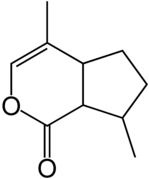
|
MultiMedia |

Custom Search
|
|
 Structural formula of nepetalactone
Structural formula of nepetalactoneNepetalactone is a lactone chemical compound first isolated in the plant catnip, Nepeta cataria (apparently named after the Italian town of Nepete). It was first isolated in 1941.
Nepetalactone's structure is two rings a cyclopentane and a cyclic ester, making a terpenoid. Empirically it is C10H14O2. The structure and the effect of the compound is similar to valepotriates. There are a number of isomers of nepetalactone.
As 4aα,7α,7aα-nepetalactone it is the active chemical in Nepeta cataria that causes its characteristic effect on cats. Around 75% of cats are affected: susceptibility is gene-linked. The chemical interacts as a vapour at the vomeronasal organ.
In humans the compound has a number of very mild effects; it is a weak sedative, antispasmodic, febrifuge and antibacterial. In high doses it also has an emetic effect.
It also has an effect on some insects, repelling the cockroach and mosquito, poisonous to some common flies, but a sex pheromone to aphids.